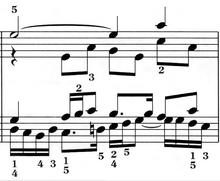Polyphony (/pəˈlɪfəni/ pə-LIF-ə-nee) is a type of musical texture consisting of two or more simultaneous lines of independent melody, as opposed to a musical texture with just one voice (monophony) or a texture with one dominant melodic voice accompanied by chords (homophony).
Within the context of the Western musical tradition, the term polyphony is usually used to refer to music of the late Middle Ages and Renaissance. Baroque forms such as fugue, which might be called polyphonic, are usually described instead as contrapuntal. Also, as opposed to the species terminology of counterpoint,[clarification needed] polyphony was generally either "pitch-against-pitch" / "point-against-point" or "sustained-pitch" in one part with melismas of varying lengths in another.[1] In all cases the conception was probably what Margaret Bent (1999) calls "dyadic counterpoint",[2] with each part being written generally against one other part, with all parts modified if needed in the end. This point-against-point conception is opposed to "successive composition", where voices were written in an order with each new voice fitting into the whole so far constructed, which was previously assumed.
The term polyphony is also sometimes used more broadly, to describe any musical texture that is not monophonic. Such a perspective considers homophony as a sub-type of polyphony.[3]
- ^ Hendrik van der Werf (1997). "Early Western polyphony", Companion to Medieval & Renaissance Music. Oxford University Press. ISBN 0-19-816540-4.
- ^ Margaret Bent (1999). "The Grammar of Early Music: Preconditions for Analysis", Tonal Structures of Early Music. New York: Garland Publishing. ISBN 0-8153-2388-3.
- ^ DeVoto, Mark (2015). "Polyphony". Encyclopædia Britannica Online. Retrieved 1 December 2015.

